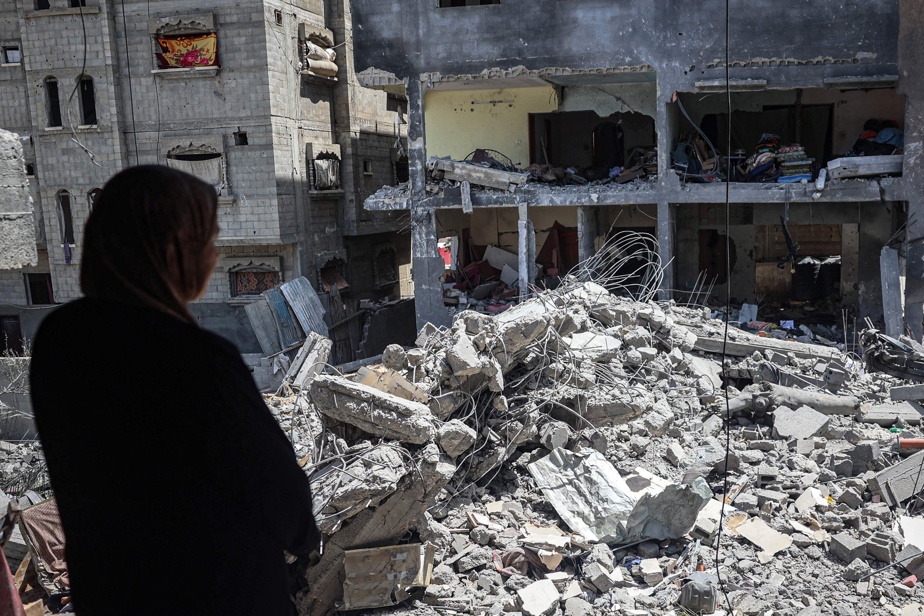The Israeli army announced the death of eight new soldiers on Saturday in the Gaza Strip, where the war between Israel and the Palestinian Islamist movement Hamas has raged for more than eight months.
On the diplomatic front, hopes for a ceasefire seem to be fading due to the contradictory demands of Israel and Hamas which leave little chance of seeing the plan announced at the end of May by the American president, Joe, come to fruition. Biden.
While residents on Saturday reported bombings and fighting between Israeli forces and Palestinian fighters in Rafah, a large city in the south of the Palestinian territory, and its surroundings, the Israeli army indicated that eight soldiers had died in this sector.
The armored vehicle in which the soldiers were “was hit by a bomb explosion,” the army said.
“Our hearts are broken by these terrible losses,” responded Prime Minister Benjamin Netanyahu in a statement.
But, he assured, “we must stick to the objectives of the war: destroy the military and governmental capabilities of Hamas, recover all our hostages, ensure that Gaza no longer poses a threat to Israel […] “.
Gloomy Eid
The Israeli army launched a ground operation on the town of Rafah on May 7, sparking strong criticism from the international community which feared for the fate of the civilian population, massed in this town after having been largely displaced by the fighting elsewhere.
Since the start of the ground operation in the rest of the Gaza Strip on October 27, 306 Israeli soldiers have been killed – including the eight soldiers who died this Saturday, one of the worst tolls for the Israeli army during just one day.
AFPTV images on Saturday show deserted streets in Rafah, a city also in the grip of a major humanitarian crisis, as in the rest of the territory. Famine threatens the Gaza Strip where 75% of the approximately 2.4 million inhabitants have been displaced by the war, according to the UN.
While elsewhere in the world, Muslims are preparing to celebrate Eid al-Adha, the major Muslim holiday, from Sunday, Palestinians in Gaza deplore the multiple shortages of basic necessities in the besieged territory.

PHOTO BASHAR TALEB, AGENCE FRANCE-PRESSE ARCHIVES
Palestinians walk along a street in Rafah, in the southern Gaza Strip, on June 14, 2024.
” The previous years [pour l’Aïd]we prepared treats, new clothes for the children, or we bought […] meat, fish and other delicious foods,” recalls bitterly Asmaa al-Masri, a resident of Jabaliya (north) who was displaced to nearby Beit Hanoun.
The war was sparked on October 7 by the attack launched by Hamas from Gaza in southern Israel, which resulted in the deaths of 1,194 people, mostly civilians, according to an AFP count established from official Israeli data. Of 251 people kidnapped, 116 are still held hostage in Gaza, of whom 41 are dead, according to the army.
In retaliation, the Israeli army launched a large-scale offensive in Gaza that left 37,296 dead, mostly civilians, according to data Saturday from the Health Ministry of the Hamas-led Gaza government.

PHOTO EYAD BABA, AGENCE FRANCE-PRESSE
A young Palestinian carrying water walks past a destroyed mosque in Khan Younes, southern Gaza Strip, on June 14.
On the sidelines of the G7 Summit which ends on Saturday in Italy, Mr. Biden criticized Hamas for blocking the ceasefire offer on the table.
Violence in the north
“I submitted a proposal approved by the Security Council, by the G7, by the Israelis, and the main obstacle at this stage is Hamas refusing to sign, even though they proposed something similar,” he said. Mr. Biden said on Thursday.
The truce plan announced on May 31 by the President of the United States, Israel’s main ally, provides in a first phase for a six-week ceasefire accompanied by an Israeli withdrawal from the densely populated areas of Gaza, the release of certain hostages held in Gaza and the release of Palestinians imprisoned by Israel.
Mr. Biden presented this plan as coming from Israel. But Prime Minister Benjamin Netanyahu deemed it incomplete, reaffirming his government’s determination to continue the war until the defeat of Hamas and the release of all the hostages.
The only truce concluded so far, at the end of November, lasted a week and allowed the release of 105 hostages, including 80 Israelis and dual nationals, exchanged for 240 Palestinians detained by Israel.
Saturday evening in Tel Aviv, thousands of demonstrators and relatives of the hostages demonstrated once again to demand their release and denounce the management of the war by Mr. Netanyahu’s government.
“Every soldier who dies is like someone from our family dies. We experience it as a collective loss,” said Graciela Barchilon, a 68-year-old protester.
Hamas sent the mediating countries – Qatar, Egypt and the United States – a first response, which according to a source close to the discussions, contains “amendments” to the plan, including “a timetable for a permanent ceasefire and the total withdrawal of Israeli troops from Gaza. Demands that Israel has always rejected.
Fears of an extension of the conflict beyond the Gaza Strip have increased in recent days. The Lebanese Islamist movement Hezbollah, an ally of Hamas, indicated that its intense strikes since Wednesday on Israeli territory were a response to the assassination by Israel of one of its commanders.

PHOTO RABIH DAHER, AGENCE FRANCE-PRESSE
Smoke rises in southern Lebanon after Israeli strikes near the border.
Again on Saturday, the belligerents exchanged new fire at the border, with a Palestinian movement reporting a death in its ranks in an Israeli strike.
During a new tour of the Middle East this week to promote the ceasefire plan, US Secretary of State Antony Blinken said the “best way” to help resolve violence between Hezbollah and Israel was “to resolve the conflict in Gaza and achieve a cease-fire.”
